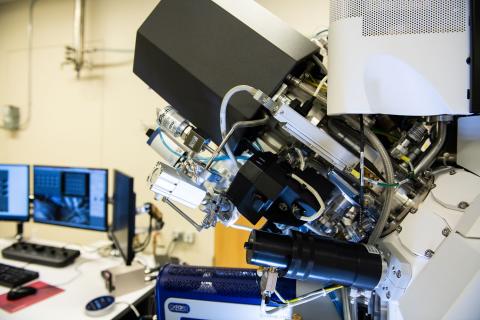Particle-based crystallization is an important pathway to synthesize advanced materials with complex structures. Unlike monomer-by-monomer addition or Ostwald ripening, particle-based crystallization occurs via particle-by-particle addition to form larger crystals. This chapter reviews the...
Filter results
Content type
Publication Type
Tags
- (-) Nanoparticles (4)
- (-) Microscopy (3)
- (-) X-Ray Spectroscopy (2)
- Omics (16)
- Viruses (10)
- Health (8)
- Soil Microbiology (8)
- Virology (8)
- Virus (8)
- Genomics (7)
- High Throughput Sequencing (7)
- Imaging (5)
- Mass Spectrometer (5)
- PerCon SFA (5)
- Sequencer System (5)
- Ions (4)
- Microbiome (4)
- sequencing (4)
- Spectroscopy (4)
- Electrical energy (3)
- Energy (3)
- Fungi (3)
- Mass Spectrometry (3)
- metabolomics (3)
- Proteomics (3)
- RNA Sequence Analysis (3)
- Sodium (3)
- Synthetic Biology (3)
- Microarray (2)
- Polymer Materials (2)
To better understand the effects of solution chemistry on particle aggregation in the complex legacy tank wastes at the Hanford (WA) and Savannah River (SC) sites, we have performed a series of tumbler small- and ultra-small-angle neutron scattering experiments on 20 wt % solid slurries of...
he production and release of H2 and O2 during and after electron (100–1000 eV) irradiation of boehmite nanoplatelet films was studied. H2 and O2 produced during irradiation likely correspond to electron-induced dissociation of the hydroxyls primarily in the terminal surface layers of the boehmite...
The theoretical prediction of x-ray absorption spectra (XAS) has become commonplace in electronic structure theory. The ability to better model and understand L-edge spectra is of great interest in the study of transition metal complexes and a wide variety of solid state materials. However, until...
X-ray, energetic photon, and electron irradiation can ionize and electronically excite target atoms and molecules. These excitations undergo complicated relaxation and energy-transfer processes that ultimately determine the manifold system responses to the deposited excess energy. In weakly bound...
The Physical Electronics Instruments (PHI) Quantum 2000 X-Ray Photoelectron Spectrometer (XPS) is a unique Micro-Focused Scanning X-Ray system that uses a focused monochromatic aluminum K X-ray beam that can be varied in size from as small as 10 μm in diameter to approximately 200 μm. The beam can...
The Nikon Eclipse Ti2-E is a motorized and intelligent model for advanced imaging applications. Compatible with PFS, auto correction collar, and external phase contrast system. The base of choice for live-cell imaging, high-content applications, confocal and super-resolution.As research trends...
Category
Stanford Synchrotron Radiation Lightsource Experimental Station 14-3b is a bending magnet side station dedicated to X-Ray Imaging and Micro X-Ray Absorption Spectroscopy of biological, biomedical, materials, and geological samples. Station 14-3b is equipped with specialized instrumentation for XRF...
Category
The innovative Elstar™ electron column forms the basis of the Helios NanoLab’s outstanding high resolution imaging performance. The Elstar features unique technologies, such as constant power lenses for higher thermal stability, electrostatic scanning for faster, higher accurate imaging, and unique...




